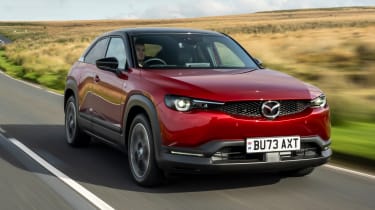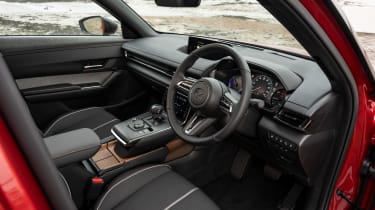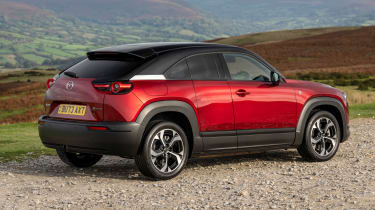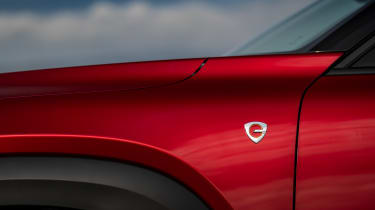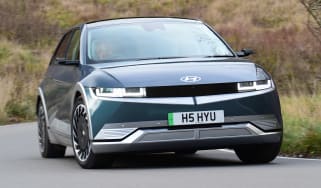New Mazda MX-30 R-EV 2023 review: the rotary engine returns
The electric MX-30 has always been hampered by its limited range, but now Mazda has introduced a rotary plug-in hybrid powertrain

Verdict
The addition of a rotary engine is an ingenious solution to the Mazda MX-30’s measly range, making this plug-in hybrid version of Mazda’s oddball crossover a much more versatile option than the original EV. Plus, without the ever-present range anxiety, the MX-30 R-EV allows you better appreciate just how capable this car is at motorway speeds, as well as the quality of its cabin. However, the coach doors continue to create more problems than solutions – the incredibly gloomy rear cabin just the first that springs to mind.
The all-electric Mazda MX-30 is not without merit, but its positives are overshadowed by the quirky EV’s meagre 124-mile range, which we found is closer to 100 miles in the real world. It made the MX-30 hard to recommend as anything other than an urban errand-runner.
The obvious solution would be to install a larger battery. But Mazda, being a brand with a history of doing things its own way, opted instead to fit the MX-30 with an even smaller battery – assisted by a rotary engine, of all things.
Unless you’re a passionate Mazda fan or Japanese sports car aficionado, you probably won’t know anything about rotary engines – or Wankel engines, if you want to get really nerdy. That’s because Mazda is the only mainstream car manufacturer to put rotary engines into mass production, using them to power some of its most iconic cars; namely the Mazda Cosmo, RX-7 and RX-8 sports cars.
More reviews
Car group tests
In-depth reviews
Long-term tests
Road tests
The new MX-30 R-EV is by no means a successor to those cars, but it is the first model in more than a decade to feature this incredibly unique motor. While conventional combustion engines use circular pistons that move up and down a cylinder, a rotary engine uses triangular-shaped rotors that spin around a central shaft.
Although in the case of the R-EV, there’s just one rotor, with the tiny 830cc engine producing 74bhp at a relatively low 4,500rpm. Rotary engines are also compact and light, so could be easily packaged alongside an electric motor under the MX-30’s bonnet. Indeed, the R-EV’s dinky rotary engine forms part of a range-extender plug-in hybrid system, with its sole purpose being to provide energy for the electric motor that actually drives the front wheels.
For the most part, the rotary emits little more than a distant hum that could easily be concealed by the radio. Under hard acceleration this grows to more of a drone, but the engine note only becomes irritating when you go beyond 70mph. We noticed that when trying to overtake other cars on the motorway, the engine produces a noise that sounds remarkably like there’s a biplane flying directly overhead. The noise continues until you finally back off the throttle, or you silence it by switching to EV mode.
There are three drive modes available: EV, Normal and Charge. As its name suggests, EV mode sends the engine into hibernation, only waking from its slumber when the battery is close to empty or some extra energy is required for hard acceleration.
Charge mode maintains a set amount of battery for use later in your journey, for instance if you’re headed into a low emissions zone and will want to drive in EV mode. We stuck with Normal mode for the most part during our test drive across North Wales, which only sees the rotary engine fire up once the battery charge drops below 43 per cent.
The R-EV’s 17.8kWh battery is half the size of the 35.5kWh unit in the all-electric MX-30. As a result, the R-EV will cover just 53 miles before the battery is flat, which isn’t bad for a PHEV. But with the rotary engine waiting in the wings to continually keep the battery topped up, Mazda says the full range for the R-EV is over 400 miles.
And with the electric motor responsible for driving the wheels, power delivery is instant, smooth and linear at any speed. The MX-30 R-EV is marginally faster than the all-electric version, but not by much, with 0-62mph taking just over nine seconds. It feels just as slow behind the wheel, although the MX-30 still leaps away from traffic lights, and packs enough power for quick bursts of acceleration.
Because of its peppiness, and light steering, the MX-30 is a good car to drive around town. It’s equally capable on the motorway – once the engine pipes down anyway – and feels very stable at higher speeds. The supple ride absorbs small lumps and bumps, while softening the harsh edges of the larger imperfections.
The MX-30 remains comfortable and composed on twisty roads, able to change direction quickly with not too much body roll. However, the tall and long bonnet makes it hard to place the car on the road, and pushing the MX-30 too far will lead it to understeer.
After covering more than 100 miles across motorways, and winding through Welsh valleys, we only managed 40mpg – a far cry from the 282.5mpg Mazda claims this setup is capable of. Of course, all plug-in hybrids need regular charging and minimal use of the engine to achieve their claimed stats; we did see a rather remarkable 5mi/kWh from the battery.
Recharging the MX-30 R-EV’s battery from 20-80 per cent via a 7.2kW home wallbox takes an hour and a half. The R-EV also gets DC charging capabilities, which is uncommon for a PHEV, so you could use a 50kW rapid charger to complete the same top-up in 25 minutes. We doubt many will stop on longer journeys to charge, however, as they can just let the rotary engine do its thing.
Inside, the MX-30 R-EV and regular EV are almost identical, which is no bad thing. The cabin feels incredibly sophisticated and mature for a crossover, and build quality is impressive. The tech on-board is also easy to use thanks to the extensive use of physical buttons and switchgear, plus the large rotary dial for navigating the infotainment system. The 8.8-inch central display itself is very sharp, although because of how narrow the screen is it doesn't give you a great view of what’s coming up on the sat-nav.
There’s lots of adjustment in the driving position, while the thin rimmed steering wheel is great to hold and features paddles to allow you adjust the strength of the regenerative braking on the fly.
The rear coach doors are still more trouble than they're worth, though. The small openings they create makes getting into the rear a challenge, and the small porthole-like windows not only don’t open, but don’t let a lot of light in, creating a rather gloomy place for passengers. The huge B-pillar and small rear windows also create huge blind spots – at least Mazda has made blind-spot detection standard-fit on every model.
The MX-30 R-EV and EV are available in the same three trim levels, and for the most part cost exactly the same. Entry-level Prime-Line models start from £31,250, and come with LED headlamps, 18-inch alloy wheels, all-round parking sensors, a reversing camera, head-up display, 8.8-inch infotainment system, plus a separate seven-inch touchscreen for the climate controls, cruise control, lane departure warning, and Apple CarPlay and Android Auto smartphone connectivity.
Upgrading to Exclusive-Line sees the price jump to £33,150, and adds an eight-way adjustable driver’s seat, heated front seats, Leatherette upholstery, keyless entry and diamond-cut wheels. Range-topping Makoto trim cars like the one we drove, cost £36,000 in R-EV form – £450 more than the equivalent EV – and get luxuries like a 360-degree parking camera setup, an opening sunroof, heated steering wheel, and a 12-speaker Bose sound system.
We tested all three versions of the MX-30 R-EV back to back and found that base models feel just as premium inside as top-spec versions, and certainly not short on kit, making Prime-Line our pick of the range.
| Model: | Mazda MX-30 R-EV Makoto |
| Price: | £36,000 |
| Powertrain: | 0.8-litre single-rotor petrol PHEV, 17.8kWh battery, 1x e-motor |
| Transmission: | Single-speed automatic, front-wheel drive |
| 0-62mph: | 9.1 seconds |
| Top speed: | 87mph |
| EV range: | 53 miles |
| Economy: | 282.5mpg |
| CO2: | 21g/km |
| On sale: | Now |

